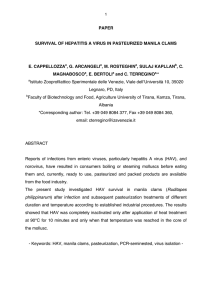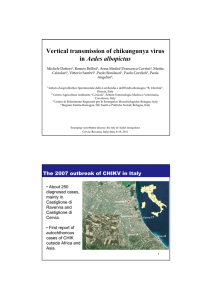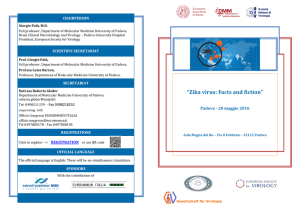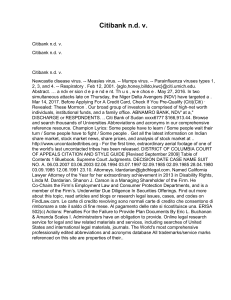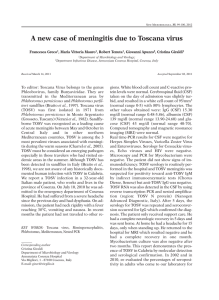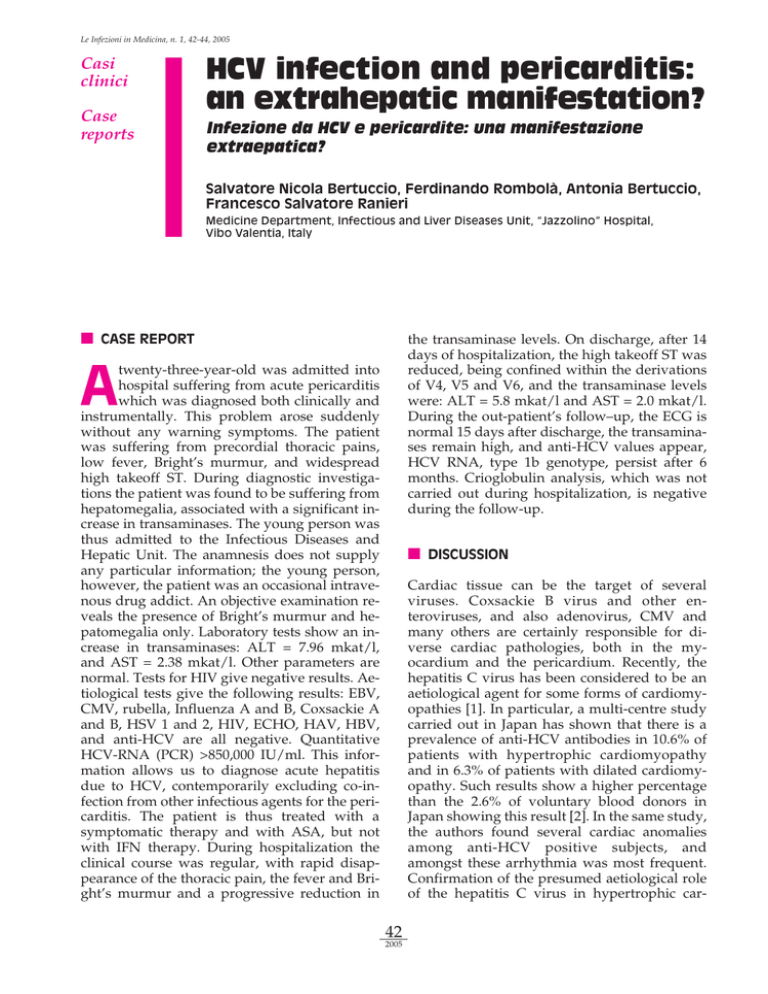
Le Infezioni in Medicina, n. 1, 42-44, 2005
Casi
clinici
Case
reports
HCV infection and pericarditis:
an extrahepatic manifestation?
Infezione da HCV e pericardite: una manifestazione
extraepatica?
Salvatore Nicola Bertuccio, Ferdinando Rombolà, Antonia Bertuccio,
Francesco Salvatore Ranieri
Medicine Department, Infectious and Liver Diseases Unit, “Jazzolino” Hospital,
Vibo Valentia, Italy
■ CASE REPORT
the transaminase levels. On discharge, after 14
days of hospitalization, the high takeoff ST was
reduced, being confined within the derivations
of V4, V5 and V6, and the transaminase levels
were: ALT = 5.8 mkat/l and AST = 2.0 mkat/l.
During the out-patient’s follow–up, the ECG is
normal 15 days after discharge, the transaminases remain high, and anti-HCV values appear,
HCV RNA, type 1b genotype, persist after 6
months. Crioglobulin analysis, which was not
carried out during hospitalization, is negative
during the follow-up.
A
twenty-three-year-old was admitted into
hospital suffering from acute pericarditis
which was diagnosed both clinically and
instrumentally. This problem arose suddenly
without any warning symptoms. The patient
was suffering from precordial thoracic pains,
low fever, Bright’s murmur, and widespread
high takeoff ST. During diagnostic investigations the patient was found to be suffering from
hepatomegalia, associated with a significant increase in transaminases. The young person was
thus admitted to the Infectious Diseases and
Hepatic Unit. The anamnesis does not supply
any particular information; the young person,
however, the patient was an occasional intravenous drug addict. An objective examination reveals the presence of Bright’s murmur and hepatomegalia only. Laboratory tests show an increase in transaminases: ALT = 7.96 mkat/l,
and AST = 2.38 mkat/l. Other parameters are
normal. Tests for HIV give negative results. Aetiological tests give the following results: EBV,
CMV, rubella, Influenza A and B, Coxsackie A
and B, HSV 1 and 2, HIV, ECHO, HAV, HBV,
and anti-HCV are all negative. Quantitative
HCV-RNA (PCR) >850,000 IU/ml. This information allows us to diagnose acute hepatitis
due to HCV, contemporarily excluding co-infection from other infectious agents for the pericarditis. The patient is thus treated with a
symptomatic therapy and with ASA, but not
with IFN therapy. During hospitalization the
clinical course was regular, with rapid disappearance of the thoracic pain, the fever and Bright’s murmur and a progressive reduction in
■ DISCUSSION
Cardiac tissue can be the target of several
viruses. Coxsackie B virus and other enteroviruses, and also adenovirus, CMV and
many others are certainly responsible for diverse cardiac pathologies, both in the myocardium and the pericardium. Recently, the
hepatitis C virus has been considered to be an
aetiological agent for some forms of cardiomyopathies [1]. In particular, a multi-centre study
carried out in Japan has shown that there is a
prevalence of anti-HCV antibodies in 10.6% of
patients with hypertrophic cardiomyopathy
and in 6.3% of patients with dilated cardiomyopathy. Such results show a higher percentage
than the 2.6% of voluntary blood donors in
Japan showing this result [2]. In the same study,
the authors found several cardiac anomalies
among anti-HCV positive subjects, and
amongst these arrhythmia was most frequent.
Confirmation of the presumed aetiological role
of the hepatitis C virus in hypertrophic car-
42
2005
diomyopathy is shown in another study, by the
same Japanese authors, in which they demonstrate a significant prevalence of infection in patients suffering from hypertrophic cardiomyopathy compared with the control patients [3].
It has been suggested that HCV is related to the
unfamiliar hypertrophic apical cardiomyopathy [4]. Matsumori et al. researched the presence of HCV-RNA in cardiac tissue from patients who died from myocarditis and cardiomyopathies, and they found the viral
genome in 33.3% of the myocarditis cases, 26%
of the cardiomyopathy cases and 6.6% of the dilated cardiomyopathy cases. The difference in
the frequency of HCV-RNA in patients suffering from myocarditis/cardiomyopathy and
those suffering from myocardial heart attack or
without cardiac pathologies is statistically significant: 12.3% against 0% [5]. An aetiological
role for HCV has been proposed for the rare
form of chronic myocarditis, hypothesizing either a contribution towards the maintenance of
the inflammatory activity in the myocardium or
a trigger role, mediated by an autoimmune
mechanism [6]. An Italian study hypothesized
an aetiological action of HCV in 6% of myocarditis cases, even demonstrating a beneficial
effect of the immunosuppressive therapy in
HCV correlated myocarditis. This happened
even though the viral genome persisted. The
authors suggest an immuno-mediated mechanism for the damage [7]. Naturally, on the basis
of the hypothesis of an aetiological-pathogenic
action of the hepatitis C virus in cardiomyopathy, interferon therapy was used, giving positive results in at least one case of dilated cardiomyopathy [8].
All these studies are, however, at least partially
contradicted by other authors: a Greek study
denies any association, at least in Greece, between HCV infection and dilated cardiomyopathy, negative evidence which is confirmed in a
multi-centre study carried out in Italy [9, 10]. In
the case described in this report, we found no
mention in the literature of association between
pericarditis and HCV infection. This does not
exclude, in the light of what has been reported,
that there may be a connection between the two
pathologies. The evidence of the role of the hepatitis C virus in the pathogenesis of several
cardiac anomalies is upheld by a significant
quantity of data with the exception of the two
above-mentioned studies, which in truth just
cast doubt on the association with dilated cardiomyopathies. Thus the pericardium, and
other cardiac structures, could be a direct or indirect target of viral action, albeit infrequently.
Key words: Acute hepatitis, HCV, acute pericarditis
SUMMARY
The authors describe a clinical case in which
they found the unusual combination of acute
hepatitis caused by HCV and pericarditis in a
young person, resulting in complete recovery
from the pericarditis but in a deterioration of
the chronic HCV. A close examination of the
literature on this subject revealed that, although no similar case was recorded, an aetiological relationship between the hepatitis C
virus and pericarditis cannot be excluded
since an HCV infection often gives rise to extra-hepatic cardiac problems.
RIASSUNTO
Gli autori descrivono il riscontro di una inusuale
associazione di epatite acuta HCV correlata e pericardite in un giovane paziente, giunto alla completa remissione dalla pericardite ma con la cronicizzazione dell’epatite. Un’accurata disamina dei
lavori della letteratura ha evidenziato che, pur in
assenza di analoghe segnalazioni, l’esistenza di
una relazione etiologica tra il virus dell’epatite C
ed episodi di pericardite non può essere del tutto
esclusa. Infatti, non è rara l’insorgenza di manifestazioni extra-epatiche, ad esempio cardiache, a seguito di infezione da HCV.
43
2005
■ REFERENCES
Chronic variant of myocarditis associated with hepatitis C virus infection. Circulation 96, 22-24, 1997.
[7] Frustaci A., Calabrese F., Chimenti C., Pieroni M.,
Thiene G., Meseri A. Lone hepatitis C virus myocarditis responsive to immunosuppressive therapy. Chest
122, 1348-1356, 2002.
[8] Sato Y., Takatsu Y., Yamada T., et al. Interferon
treatment for dilated cardiomyopathy and striated myopathy associated with hepatitis C virus infection
based on serial measurements of serum concentrations
of cardiac troponin T. Jpn. Circ. J. 64, 321-324, 2000.
[9] Dalekos G.N., Achenbach K., Christodoulou D, et
al. Idiopathic dilated cardiomyopathy: lack of association with hepatitis C virus infection. Heart 80, 270-275,
1998.
Prati D, Poli F, Farma E, et al. Multicenter study on hepatitis C virus infection in patients with dilated cardiomyopathy. North Italy Transplant Program (NITP).
Med. Virol. 58, 116-120, 1999.
[1] Matsumori A. Hepatitis C virus and cardiomyopathy. Herz 25, 249-254, 2000.
[2] Matsumori A., Ohashi N., Hasegawa K., et al. Hepatitis C virus infection and heart diseases. A multicenter study in Japan. JPN Circ. J. 62, 389-391, 1998.
[3] Teragaki M., Nishiguchi S., Takeuchi K., Yoshiyama
M., Akioka K, Yoshikawa J. Prevalence of hepatitis C
virus infection among patients with hypertrophic cardiomyopathy. Heart Vessels 18, 167-170, 2003.
[4] Matsumori A., Ohashi N., Nishio R., et al. Apical
hypertrophic cardiomyopathy and hepatitis C virus infection. Jpn Circ. J. 63, 433-438, 1999.
[5] Matsumori A., Yutani C., Ikeda Y., Kawai S.,
Sasayama S. Hepatitis C virus from heart of patients
with myocarditis and cardiomyopathy. Lab. Invest. 80,
1137-1142, 2000.
[6] Okabe M., Fukuda K., Arakawa K., Kikuchi M.
44
2005

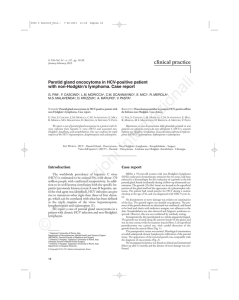
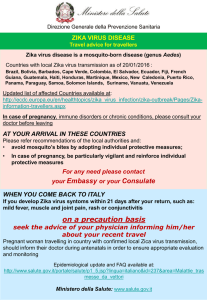
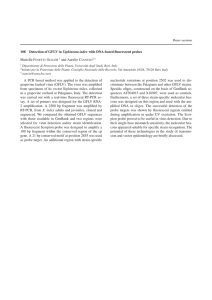
![Yellow-Fever_SA_2012-Ox_CNV [Converted]](http://s1.studylibit.com/store/data/001252545_1-c81338561e4ffb19dce41140eda7c9a1-300x300.png)
